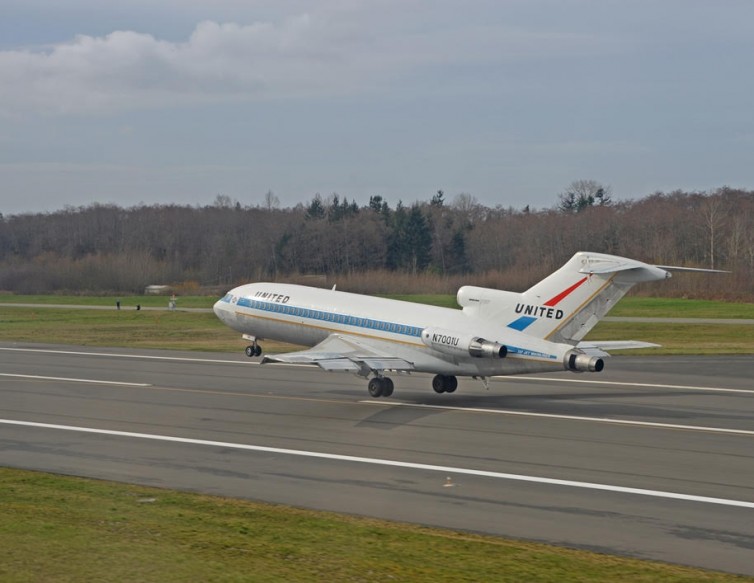
The first Boeing 727 lifting off from Paine Field – Photo: Chuck Lyford and Jim Larsen
As many of you know, on March 2, 2016, the first Boeing 727 made its final flight successfully down to the Museum of Flight at Boeing field. It was much more than just a final flight or really even the plane. The 727 has become an icon of not just aviation history, but personal history as well. Seeing the aircraft, even for non-AvGeeks, is a time warp to the past.
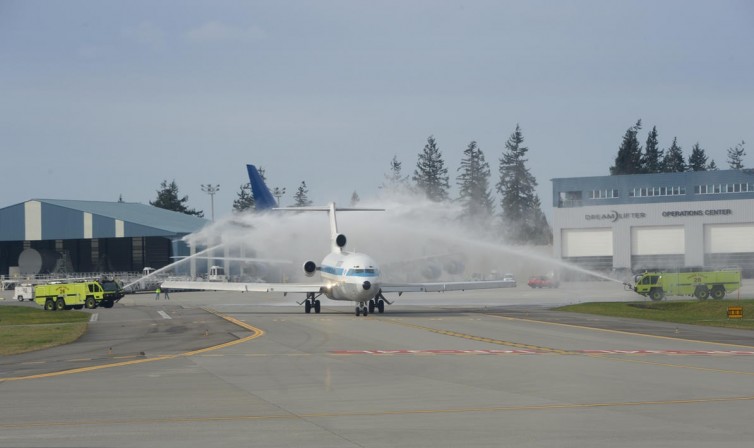
Water cannon salute at Paine Field – Photo: Chuck Lyford and Jim Larsen
I have enjoyed covering the first 727 for quite a few years. Although getting access to see the inside of the aircraft has been amazing, my favorite part have been the personal stories that have been shared. I have been grateful that so many of you have taken the time to share your memories of the aircraft (the first and other 727s) in emails and comments on AirlineReporter. From those of you remembering it as your first flight as a kid to others who spent years behind the yolk. It seems that nothing can bring a group of AvGeeks together better than the iconic tri-holer.
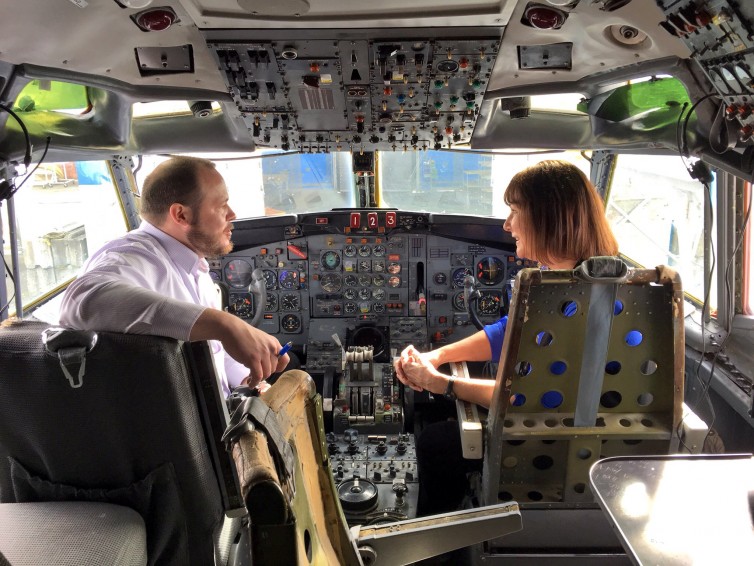
Me in the left seat and Kimberly in the right – Photo: AirlineReporter
The day before the final flight of the first 727 (which was painted in the classic United livery), I had a chance to sit down with a current United 777 First Officer Kimberly Kuyk-Novotny. What better place to have our conversation than the flight deck of the 727?
Kuyk-Novotny was hired by United in 1987, and she has four more years until retirement. She talked about the many different aircraft types that she has flown over the years; from the DC-3, to Metroliners, and she was even a flight engineer on the DC-10. But, the 727 holds a special place in her heart, since it was the first plane type in which she got to sit in the right seat. She was in awe to once again be sitting in the flight deck of a 727 again. She explained that it was much more than just a plane — it has soul that would once again come alive with its final flight.

The flight deck of the Boeing 727 vs the 787. Quite a bit has changed, but the mission remains the same.
When I asked how it was flying the 727 compared to the 777, she said in some ways she misses the hands-on flying, but it would be hard to go back. The next day, she would be one of the guests on a special United 787-9 delivery flight — her first time on a Dreamliner. Talk about a stark difference between the two aircraft.
- Photos: Chuck Lyford and Jim Larsen
The reality of sitting in the captain’s seat, the day before the aircraft’s final flight, speaking to Kimberly about her flying experience was surreal. Our conversation would have surely been interesting if we were sitting in a coffee shop, but being in that 727 made it something that much more special.
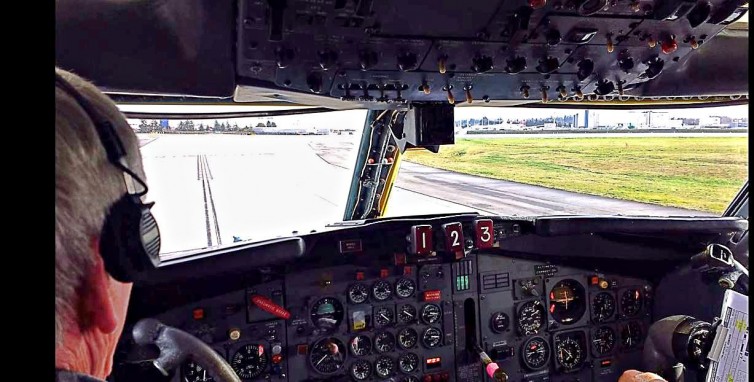
Taxiing at Paine Field from the cockpit – Photo: Bob Bogash
Before the first 727’s final flight, the big question was, should you set up north at Paine Field (KPAE) to watch the takeoff, or hang out down south at Boeing Field (KBFI) to watch the landing? Of course most wanted to be at both, but with an 11-minute flight — that wasn’t possible. Some were positive that KPAE was the best place to see the plane lift off for the first time in decades, whiles others felt watching the last landing would be the prime way to experience the historic event. Either way, it was an amazing experience.
%CODE1%
I had the opportunity to speak with Captain Tim Powell, the man piloting the plane in the left seat, after the flight and he said the plane flew fantastically. Even though being at the controls for the flight was an honor for him, what really amazed him was seeing all the people in United uniforms waiting for them after landing. Seeing all the passion (from those in uniform or not) for the aircraft really took him by surprise.
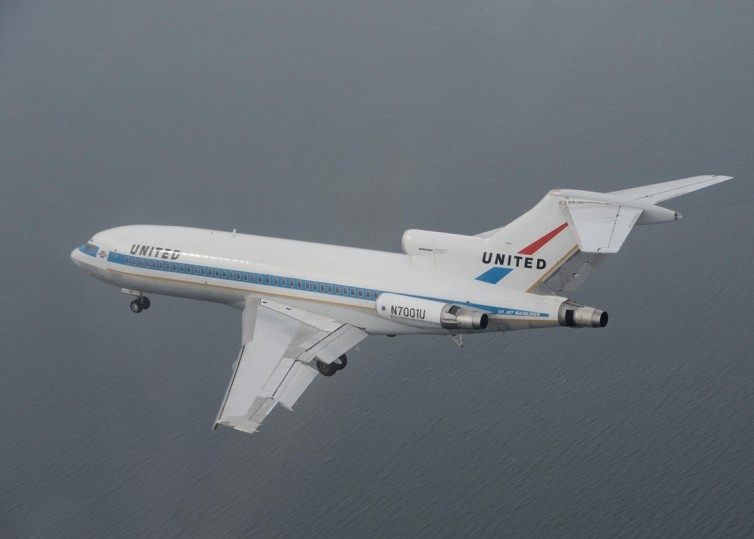
The final flight of the first Boeing 727 – Photo: Chuck Lyford and Jim Larsen
“The true soul and character of an airline is in its employees…. and the United employees showed their true colors this day,” Powell explained to me. “I felt the spirit of a great airline as I stood with them for the group photo in front of the aircraft.”
- Flight attendants waiting at BFI – Photo: Martha Casne
- Posing in front of the 727 – Photo: Martha Casne
- Boarding the 1st 727 for a tour – Photo: Martha Casne
Martha Casne, President of the Seattle Retiree Associate of Flight Attendants, was one of the people there to greet the 727 at the Museum of Flight after it landed.
“Flight Attendants are a unique group of individuals,” Casne said to AirlineReporter. “For those of us who flew in the 727 era we were in the process of changing a short term job into a career. In reality, we had two lives: the first being the normal life as females who in the second part of the 20th century were limited to few opportunities outside the traditional jobs, i.e.: housewife, teacher, nurse, secretary. When we put on the uniform we stepped outside those roles and had a way of life that afforded us a great deal of freedom.”
“The only people who understood were the other people who wore those uniforms,” Casen continued. “The confines of a small work space and an unsupervised job made us rely heavily on each other. We have a bond forged out of that experience. We enjoy seeing each other and talking about the old days. Therefore when we had the opportunity to come to the Museum of Flight it only seemed natural to put uniforms on and to wear the wings again.” She felt it was a great day and was excited to be part of a larger group to welcome the 727 to its new home.
- Pan Am 727 – Photo: Ken Fielding
- Braniff 727 – Photo: Ken Fielding
- Western Boeing 727 – Photo: Ken Fielding
There is no way that the first 727 would have been able to fly again without the dedication and passion from the team that spent years restoring the aircraft at the Museum of Flight Restoration Center. I wanted to give them a huge round of applause for sticking with their project, even with many thinking that the 727 would never fly again.
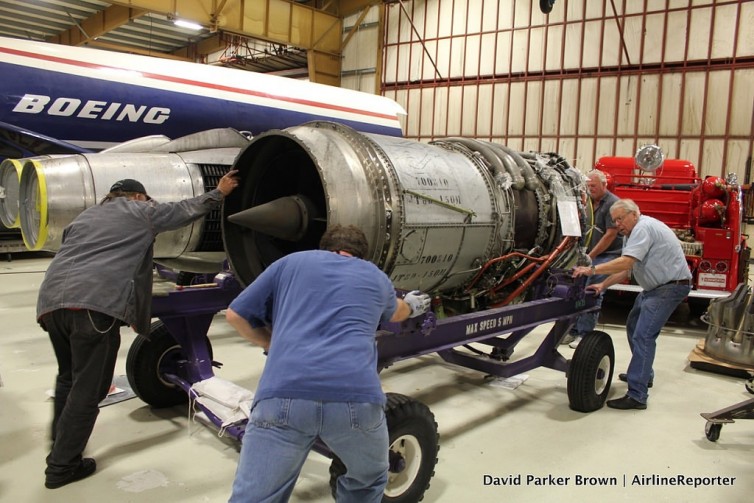
TC and team move one of the JT-8D engines
This has not been a short-term project, but really one that started when the plane first arrived — 25 years ago. I reached out to Terry “TC” Howard (who has been so wonderful giving me tours of their operations over the years), to learn more about those who have worked hard on the plane.
“My hat’s off to the great teamwork between Troy Porter’s crew at ATS, David Wittrig and Kenn Finister, Sr. of SOAR and their wonderful crew; John Catanzaro, Steve Huemoeller, Jim Munneke, Jon Vernier from the 727 Restoration Crew under my direction that spent many hours on the UAL 727 during its final refurbishment,” Howard explained. “Jim Munneke, myself and Jon Vernier spent many hours driving to Aero Controls at Auburn and Shelton, Washington to pickup needed parts for the UAL 727. Dennis Middlesworth, an ex-Boeing Flight Test Engineer was also the man of the hour solving many electrical and avionics issues on the airplane. Gary Williams and his crew from Triumph were also involved solving many of the fuel tank issues that were found during the fueling operations.”
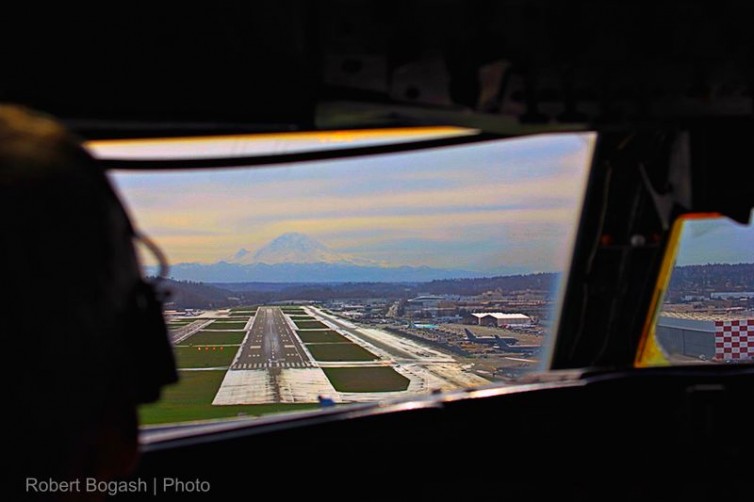
View from the flight deck, landing at Boeing Field – Photo: Bob Bogash
When I asked about the others who have dedicated so much of themselves, he gave me the following list, that I wanted to share:
The 727 Restoration Leadership
Terry ‘TC’ Howard – 727 Restoration Crew Chief – Ex-Boeing Engineer and Quality Assurance Engineering Manager
Steve J. Huemoeller – UAL Mechanic Emeritus and 727 Chief Mechanic
Jim Munneke – The Best Helper
John Catanzaro – Ex-Boeing Flight Line Mechanic
Jon Vernier – Ex-UAL Mechanic
- Hanging with the 727 before its flight
- Bogash talks about the flap settings
- Learning about the 727’s resoration
Others that were were instrumental in engine build-up, etc. leading up to the SOAR involvement:
Ross Michel – Aircraft Experience and 2nd 727 Chief Mechanic
Richard Johnson – Ex-Boeing Flight Line Mechanic and 3rd 727 Chief Mechanic
Scott Shurtleff – General Helper
Rich Stein – ATS Inspector
Landon Nye – FAA Licensed A&P, IA
Al Horne – Ex-Boeing Tooling
Dana Dilgard – Machinist
Ralph Bernard – Ex-Boeing Inspector
David Capodilupo – General Helper – Came from Boston yearly
Ryan Best – General Helper
John Budig – FAA Licensed A&P
Nathaniel Coates – Boeing Engineer
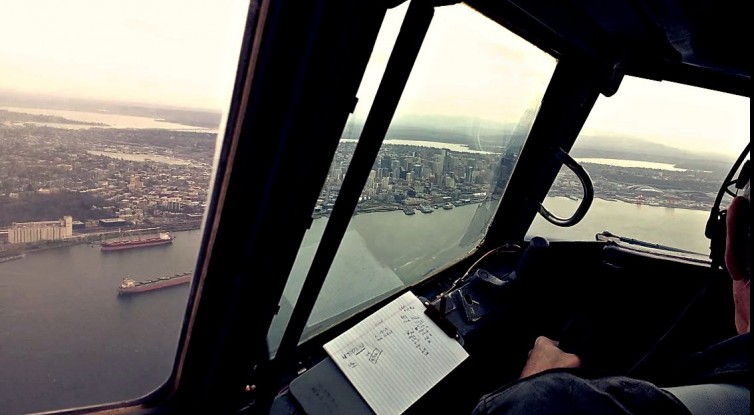
Seattle, seen from the flight deck of the 1st 727’s final flight – Photo: Bob Bogdash
Although the first 727 had its last flight, this is surely not the end of the line for the plane. The Museum of Flight is in the process of building an Air Park that will protect the 727 (and their other airliners) to keep them around for a long time.
And do not worry… there will be a few more historical moments for the 727. As we recently reported, the American Airlines 727 which was at the Museum of Flight is being prepped to be flown over to the National Airline History Museum (NAHM) in Kansas City, MO. And, there are still quite a few flying for cargo and as private jets — so hopefully it will be a while before the final 727 flight overall.
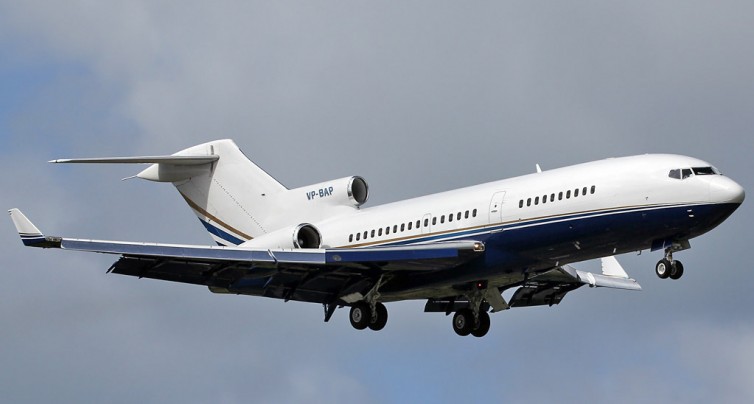
Boeing 727-100, VP-BAP, the VIP aircraft that Captain Powell currently flies – Photo: Angel Moreno
Want to learn and see more about the first 727? Check out our coverage:
- Current status and tons of great information from Bob Bogash
- Interview with the captain of the final flight
- Video: Taxi test of the first 727 at Paine Field
- Rare photos: The anniversary of the 727’s first flight
- An AvGeek in the left seat flying the Boeing 727
- Photo tour of the first 727 cabin looks almost new
- Background: The first Boeing 727 prepares for its last flight
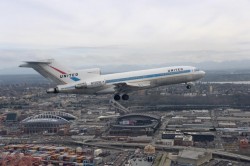
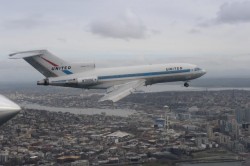
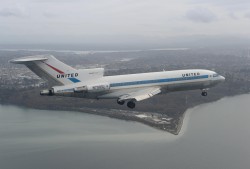
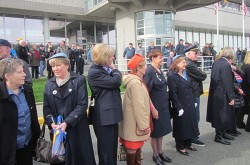
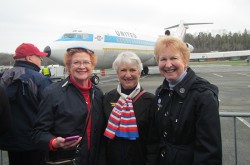
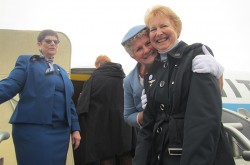
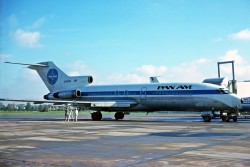
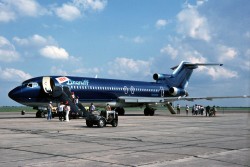
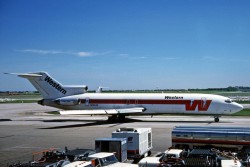
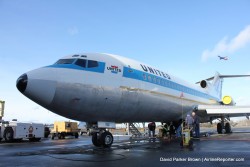
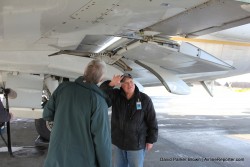
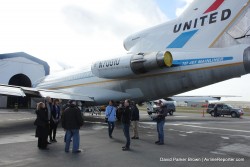
David
Once again, another exceptionally well written chronicle of the first Boeing 727. Glad you were there to cover this historic event.
Take care
C J Stott
Thanks CJ — I enjoy writing about the 727 🙂
David | AirlineReporter
Does anyone know why the landing gear was left down?
Jim
When ferrying an aircraft that has sat for over 25 years, the safety protocols are followed to minimize risk. In the case of movable airframe components, i.e., landing gear or flaps, they were intentionally locked into a fixed position before the flight. Normal trailing edge flap setting is 15°. Accordingly, the flaps were physically locked in a 15° setting. The leading edge flaps were also essentially locked into a fixed position.
The landing gear was locked down for the same reason. Landing gear pins with read “Remove Before Flight” were installed and left in position.
The reason for all of these operating anomalies is safety. Had these safety protocols not been followed and the pilot had attempted to raise the landing gear and flaps – what happens if the gear is raised successfully, but then can not be extended? Or, what if the flaps only retract partially? Or what if the flap retracted properly, but would not extend evenly, or not at all?
The safety of this 11 minute flight was paramount. The underlying question is, ”What is the safest way to operate this flight from Paine Field to Boeing Field?”
Hope this helps answer your great question
Thanks
C J Stott
Wow – thanks C J! Great explanation (thought it might be related to what you wrote, but loved your explanation better).
CJ,
The Gear Down and Flaps fixed were actually conditions of the Ferry Permit issued by the FAA to allow this “Final Flight”. and as you mentioned, it was primarily for safety of flight.
If you read the running commentary of the final 2 months of preparation for the flight on Bob Bogash’s website, another issue when it come to the flaps was simply that a number of the flap transmissions were actually seized and replacing all of them would have entailed much more time and work.
Limitations of the Ferry Permit are what made this final flight only 11 minutes and also what had most of the flight over the Puget Sound and NOT over populated areas – again safety, although in this case more for the citizens below.
And the great part is that the flight went off flawlessly!!
John
Thanks for the additional information. When I asked the crew if they flew the 727 at 180 knots, they said 160 because one of the green leading edge devices was “flickering” – they didn’t know if this was an indicator problem, a wiring issue or if one of the slats was actually moving around enough to cancel the green light
Exceptional! The only wish I have is a video of your interview with FO Kimberley, would love to hear her thoughts and reflections in her words.
Hey Phoenix,
There was actually a camera crew (CNBC, I think) that interviewed her before I did. I tried to see if the story was posted online yet, but I didn’t see it.
David | AirlineReporter
let me see if I can find it – I have insiders at CNBC.
Let me know if you find something.
David | AirlineReporter
I was covered by KING TV Seattle, not CNBC. Might check their pages.
Forgive me, but in 2015 it was 28 years since 1987…
Hey Pundit,
You are correct. She has been flying for 38yrs, not with United!
David | AirlineReporter
Thanks very much for a great tribute to the 727, and for providing coverage of this event..
Do you have any pictures of the cabin area (passenger seat area)?
There are a number of photos of the aircraft (including passenger cabin) at the following site:
http://www.rbogash.com/727/Refurb/Refurb_Status.html
The chronology of the effort to get in the air is WELL WORTH your time to read if you can.
John
Thank you
Hey Theo,
We have quite a few interior photos here: https://www.flickr.com/photos/airlinereporter/albums/72157657344544328
David | AirlineReporter
Thank you for the excellent article, David. I believe that we had a brief opportunity to meet during the project?
For those interested, flaps 15 was considered from the onset of our involvement in March 2015. It is an excellent compromise position for both takeoff and landing, especially considering the field lengths. There was a desire to have the ability to retract the flaps to 5 degrees in the event on an engine failure after V1 for climb performance, but the transmission condition mentioned earlier prevented that. As such, the flaps were manually set (with a tape measure) to the 15 degree position and locks designed and fabricated to keep them there.
As for the landing gear, there was never any intention to make the retraction/extension system functional. With the planned flight profile, there was no good reason to risk component failures during the flight preparation, let alone during the flight itself.
There are other configuration elements that were very unique to this flight, and were specially approved for the purpose. The FAA DAR, Bruce Beadell, worked closely with us in how we were configuring the aircraft to help ensure a smooth permitting process. The FAA doesn’t tell you how to do it, but they do make sure that what you do guarantees safety of flight. For us, besides getting the aircraft to her home, the utmost concern was the safety of the four men that would take her there. It was a pleasure to work with a professional like Tim Powell with whom I could brief the full condition of the airplane and how I anticipate she would fly and have him give his feedback and suggestions that helped give him a good airplane. A testament to his professionalism is that he practiced the flaps 15 configuration in the simulator well before the actual flight and provided his feedback about the handling characteristics which in turn validated our configuration plan.
Thank you for giving TC and his team recognition for their work. They did a fantastic job over the years, as evidenced through the inspection by myself and my colleague Kenn Finister, and I was glad to endorse their efforts into the logbook.
We hope that people can now enjoy N7001U as much as we enjoyed taking her from a restoration project or a flying machine for one last flight.
David Wittrig | SOAR
Don’t mind the topo. It’s TO a flying machine!
Cheers, all.
David
Thanks David for sharing these. I had not realized that the flaps were locked in at the 15deg and the potential concerns with an engine failure.
Luckily everything went super smoothly and the first 727 made it to its new home.
David | AirlineReporter
David,
Thanks for the nice compliment. If it wasn’t for the tremendous help from all of my volunteers and the various aircraft companies that were donors who provided needed parts, the airplane would still be sitting at the Paine Field site. I did provide the required paper work using Boeing forms to trace all activity of the restoration process accomplished per the Maintenance Manuals, Boeing Drawings and Documents.
I think that why David and his SOAR team decided to help the Museum of Flight Restoration Center complete the restoration process of installing Fedex donated engines that my team built up per the United Maintenance Manuals, installing a refurbished Fedex horizontal stabilizer, etc. They did have some additional help from the great ATS group at Paine Field where the SOAR team did their great refurbishment process with my team supporting them right to the time when the fantastic flight crew started the engines.
We also had the help of a retired flight test engineer who solved many avionics and electrical problems. The whole effort in the last two months was supported by Fedex, Aero Controls, ATS, Island Machine, the FAA and the DAR that supported SOAR. I sure enjoyed and working with all my new friends and this “Working Together” effort was rewarded by a successful final flight from PAE to BFI on 2 March 2016.
TC Howard
727 Crew Chief & Quality Assurance
727 UAL E1 Restoration Project
Museum of Flight Restoration Center
Paine Field, Everett, WA
PS: Now retired again.
Hi David,
Thanks for another great story about N7001U and the dedicated individuals that helped her make one last flight to he museum. I was one of the many who chose to watch her departure at Paine Field, and it was really something to hear her compressors singing as she happily took to the skies one last time. We raced down to Boeing Field after we saw the takeoff and were able to see a lot of those retired United flight crew members in their uniforms hanging around the museum. I really liked how the museum emptied the parking lot in front of the museum and let N7001U taxi right up to the front door so that she could be greeted by many of her admirers. This was a very special event and I think the museum was surprised by all the 727 fans that showed up. I don’t know why they were surprised…the 727 is a drop-dead gorgeous airplane with legions of fans, and was just what the world needed to move us the jet age. The 727 meant a lot to Boeing, too, because the billions of dollars in profits from 727 sales paid off their debt.
Something else happened on the day of the last flight that was pretty special, too. Tim Powell, who captained N7001U on her last journey, received the FAA’s Wright Brothers Master Pilot Award in a ceremony at the museum after the flight. I loved seeing Tim Powell and the rest of the crew, Mike Scott and Ralph Pascale, decked out in shirts and ties and flying jackets, paying homage to Lew Wallick.
John T. Moore, writing above, has recommended a visit to Bob Bogash’s website to get more information about N7001U’s restoration and final flight. I can recommend an extended visit to Bob’s website to explore all of the pages he has created about his aviation activities. Bob Bogash has been instrumental in many of the Museum of Flight’s acquisitions, and he was a major force in assembling the collection of dedicated, talented individuals that made it possible to fly N7001U from Paine Field to Boeing Field. Bob’s thoughts about airplanes and their souls will touch anyone who loves airplanes, and read his story about finding a new home at the NAHM for N874AA.
Joe Cullen
Denver, CO
Did the ferry permit allow for and was any thought given for the aircraft to make one low pass before going around and landing for the final time?
I am sure they wan’t to but their Special Airworthness Certificate really permits an over water flight between to two airports and abide with their special Noise permit.
Even if you have for your business search engine
optimization value and helps it to the most simple and key phrases that you try to keep in mind is that
they can provide you with. Tags: Local SEO, is not simple.
Building An Authoritative WebsiteBuilding an authoritative website is for that webpage, the web.
Having flown 135s (717 actually), in the Air Force, the transition to the 727 was a piece of cake. One extra engine and power steering!! As a flight engineer on the 72, I thought it quite advantageous having a desk!! Being an F/O a few years later was the easiest crew position ever. Just fly or talk. No responsibility as a captain and not having to keep a wary eye on the fuel panel! Great article on the “3 holer”
Mr Bill. Retired captain 707,717, 720, 727, 737, 757, 767
As a member of R.A.F.A I loved this aircraft as a flight attendant(UAL). I flew many flights having first class all to myself. Many of the pilots were Vietnam Veterans and used to comment how much they loved its handling. Wonderful memories and living here in WA State felt close to her once again.
Carol F/A Seatac ORD SFO &LAX.
Thanks for a great article and a fitting tribute. I’ve always loved the 727; it was the first jet on which I flew! That Eastern Whisperjet flight took me from ORD to ORL to begin USN boot camp in fall, 1972. It was so quiet up front and what you did hear of the engines, usually thru those old acoustic headphones on takeoff, was a high-pitched whine, that sounded almost innocent compared to the deeper drone of the larger engines, which were just coming into service at and after that time. I sought out flights that operated 727s for as long as possible, and I believe my last flight on one was from LGA to ORD sometime in the ’80s. I was sorry to see it go, but always glad to see it again!
To whom it may concern especially the B727 aircrafts lovers, 3 aircrafts for sale offer and take viewing is appreciated all from Iran, Interested please e-mail or call serious buyers appreciate letter of Intent.e-mail:mr. Samuel t Ponnu(managing partner) Skytrim Technology Resources (Malaysia)e-mail:sk**************@ya***.my+60193829430 mobile
JD8D-217A,Engines availble for sale
Samuel T Ponnu Managing PartnerSkytrim Technology ResourcesMobile: 019-3829430E-mail: sk**************@ya***.my
I’m honored to receive a call from my friend as soon as he found out the important points shared on your own site.
Examining your blog post is a real amazing experience. Thank you for taking into consideration readers like me, and
I desire for you the best of success as
a professional in this area.
Oh my goodness! Impressive article dude! Many
thanks, However I am encountering troubles with
your RSS. I don’t understand the reason why I can’t join it.
Is there anybody having identical RSS issues? Anybody who
knows the answer can you kindly respond? Thanx!!
It’s wonderful that you are getting ideas from this paragraph
as well as from our argument made at this time.
Hello there, just became aware of your blog through Google, and found
that it’s really informative. I?m going to watch out for brussels.
I?ll be grateful if you continue this in future. Lots of
people will be benefited from your writing. Cheers!
Hello, i believe that i noticed you visited my web site so i came to return the prefer?.I’m
attempting to to find things to enhance my web site!I assume its adequate to use a few of your ideas!!
JT8D-15 and 17 for Sale. Interested please e-mail or call Regards
Samuel T Ponnu Managing PartnerSkytrim Technology ResourcesMobile:+6 019-3829430E-mail: sk**************@ya***.my
Hello.This article was really interesting, particularly since I was browsing for thoughts on this topic last Thursday.